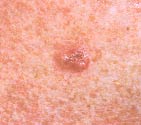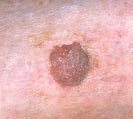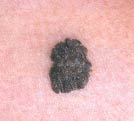|
|
Skin Cancer
 Skin cancer, usually results from prolonged exposure to sun. Most skin
cancers are curable, but one form, malignant melanoma, can be fatal. Skin cancer, usually results from prolonged exposure to sun. Most skin
cancers are curable, but one form, malignant melanoma, can be fatal.
Regions of high sunshine levels and habits of
sun-worship pose a greater
risk for skin cancer amongst individuals.
Fair skinned women are at a greater risk for skin cancer as compared to
their counterparts, because of the greater production in the latter of the
sun-protective skin pigment called Melanin.
Besides, skin cancer occurs most often on those areas of the body that are
repeatedly exposed to the sun-the face, chest, back, shoulders and legs.
Whenever you go in for a regular check-up to your physician, ask him/her to examine
your skin for signs of cancer.
Also, check the skin of your body every month for the signs of new growths or
changes in existing one. Pay more attention on the areas that are more
frequently exposed to the sun-including your scalp, face, ears, shoulders,
chest, back, arms, legs the back of your hands and the top of your feet.
Follow these steps underlined below to do a self-examination:-
(1) Examine your body, front or back in the mirror. Look at your shoulders
and raise your arms and look at your right and left sides.
-
Use a hand mirror to look at the back of your neck and the top and back of
each year, while standing in front of the mirror. Examine your back and
buttocks.
-
Bend your elbows and look carefully at your forearms the back of your
upper arms and the back of your hands.
-
Examine the top and bottom of your feet and the spaces between your toes.
If your tend to observe:-
-
Sore skin that refuses to heal and ulcerates or continually bleeds.
-
Appearance of a mole.
-
A change in the colour size, symmetry or border of moles/skin
spots
-
A tendency in a mole to bleed immediately consult a physician.
TYPES OF SKIN CANCER
Skin cancer can be anyone of the three types:-
Above two can be treated, but one form of cancer (skin) that can be fatal is
the Malignant Melanoma.
(1) BASAL CELL CANCER:-
This is the most common type of skin cancer, occurring in the top layer of
the skin. You are at increased risk of this cancer, if your have a family
history of the cancer or if your have a fair skin.
Because basal cell cancer rarely spreads from the original site to the other
parts of the body, it is seldom life threatening. |

|
CAUSES
Long term exposure to the sun is the major cause of Basal Cell Cancer. These
tumors are more common in people living near the equator. They may also occur
in scars following vaccinations, trauma or X-irradiation.
SYMPTOMS
You may notice a firm, pearly, or waxy looking lump, or a flat,
skin-colored
or brown spot that resembles a scar. A basal cell cancer sometimes might look
like a sore that never heals.
Without treatment lesions may reach 1-2 cm in diameter over 5-10 yrs.
Sometimes this type of tumour becomes cystic or pigmented.
DIAGNOSIS
If your doctor suspects Basal Cell Cancer by its appearance, he or she might
suggest a Biopsy. For the biopsy, the doctor removes all or a part of the
suspicious lump or spot and sends it to the laboratory to be examined under a
microscope for cancer cells.
TREATMENT
The treatment of Basal Cell Cancer depends on the size, depth and location of
the same.
(A) In most cases, the tumour is cut out surgically in a simple procedure
using local anesthesia. You will probably have a flat white scar afterwards. It is especially helpful when the doctor is not sure of the shape and depth of the tumor. In addition,
Mohns' technique is used to remove large tumors, those in hard-to-treat places, and cancers that have recurred. The patient is given a local anesthetic, and the cancer is shaved off one thin layer at a time. Each layer is checked under a microscope until the entire tumor is removed. The degree of scarring depends on the location and size of the treated area. This method should be used only by doctors who are specially trained in this type of surgery.
(B) In an alternative procedure, the tumour is
shaved off one layer at a
time. As each layer is removed, it is examined under a microscope for cancer
cells until all the cancerous layers have been removed.
(C) Other treatment for Basal Cell Cancer include freezing (cryosurgery) or electro surgery,
which uses an electric device to destroy cancer cells. In cryosurgery, liquid nitrogen is applied to the growth to freeze and kill the abnormal cells. After the area thaws, the dead tissue falls off. More than one freezing may be needed to remove the growth completely. Cryosurgery usually does not hurt, but patients may have pain and swelling after the area thaws. A white scar may form in the treated area.
(D) If the tumour is large, skin grafting might be done by using skin from
another part of your body to replace the missing tissues.
(E) Radiation therapy can also be an effective treatment for basal cell
cancer. It involves the use of high power X-rays or radioactive materials to
kill the cancer cells. Radiation is also sometimes used before surgery to shrink
a tumour or after surgery to destroy any remaining cancer cells.
In most cases, the basal cell cancer is completely cured. However, you should
continue to see your doctor for regular check-ups to monitor your skin for
abnormal growths.
As a preventive measure , people should avoid exposure to the midday sun (from 10 a.m. to 2 p.m. standard time, or from 11 a.m. to 3 p.m. daylight saving time). Keep in mind that protective clothing, such as sun hats and long sleeves, can block out the sun's harmful rays. Also, lotions that contain sunscreens can protect the skin. Sunscreens are rated in strength according to a sun protection factor (SPF), which ranges from 2 to 30 or higher. Those rated 15 to 30 block most of the sun's harmful rays.
(2)
SQUAMOUS CELL CANCER
Squamous Cell Cancer occurs in the cells of the top layer of the skin. It
begins as a small firm, painless lump or patch on the skin that slowly enlarges.
This type of cancer is less common. |

|
CAUSES
Squamous Cell Cancer is too caused by exposure to the sun and occurs in the
area of the skin that are most often exposed to the sun, especially the face,
lips, ears, or back of the hands.
This type of cancer often arises in the skin damaged by long term
ultra-violet radiation but also by X-ray-and infra-red rays.
Patients with certain rare genetic disorders with defective DNA repair
mechanisms, such as xeroderma pigmentosum also develop multiple basal and
squamous cell cancer.
Squamous cell cancer is more aggressive than the Basal cell cancer-it spreads
more rapidly and can be fatal. However, once detected and treated at an early
stage, it is almost always curable.
SYMPTOMS
A squamous cell tumor is a firm
skin colored or red lump or a scaly or crushed patch on the skin that is
usually painless. It may look like a sore that never heals. The tumor is common
on the lip and in the mouth where it may proceed like leukoplakia.
It may become painful if it forms
an ulcer or bleeds. A squamous cell tumor usually begins in a normal skin, but
it can also develop in a scar, or a pre-cancerous skin tumor that can occur in a
condition such as actinic keratosis (skin disorder characterized by patches of
reddish brown raised, scaly skin that results from long-term exposure to the
sun.
DIAGNOSIS
It your doctor suspects squamous
cell cancer by its appearance, biopsy might be done.
TREATMENT
Most of squamous cell tumors are
removed by cutting them out or burning (electrocautery).
Besides treatment is similar to
that for Basal Cell Cancer the cure rate for squamous cell cancer is very high,
if it is detected at an early stage.
(3)
MALIGNANT MELANOMA
Malignant Melanoma is the tumor of
the pigment cells, which begins as a brown or black mole and is never hairy.
If not detected early, malignant
melanoma often spreads to the lymph nodes (infection-fighting glands) and other
parts of the body. |

|
Moles (larger ones) that are
present at birth are more likely than other moles to eventually become
cancerous. However, melanoma can also develop in a newer mole or in normal skin.
The tumor is rare before puberty
and in areas of low incidence (including UK) , the tumor is twice as common in
females.
CAUSES
Those with blond or red hair, fair
skin which tans poorly, many freckles and Dysplastic
naevi and a family or
personal history of a previous melanoma, have an increased risk of developing
the tumor.
People whose immune system is weakened by certain cancers, by drugs given following organ transplants, or by AIDS are at increased risk of developing melanoma.
Having many moles also increases the risk of developing this disease.
The incidence of malignant melanoma
is increasing dramatically-faster than any other kind of cancer because more
people are spending their leisure time outdoors in the sun. Sunlight is the most
important cause of developing malignant malenoma. Sunburns in adulthood are also a risk factor for melanoma
It usually occurs on the trunk,
arms or lower legs. But black and other people with dark skin are not immune to
malignant melanoma, in people with darker skin, the cancer usually develops on
the palms of the hand or soles of the feet.
Melanoma has the potential to
spread rapidly and be fatal. If you view any of the symptoms mentioned below
immediately consult a physician.
SYMPTOMS
-
Change in size, shape, color of
a mole. The mole may begin to grow or to have an irregular shape or to
become lighter or darker in color. It may develop a darker border that
spreads into the surrounding skin.
-
The existing mole might begin
to bleed without being scratched or become itchy.
-
The mole might become thicker
and lumpy.
Be vigilant about watching for
changes in a mole that you have had since birth, which is more likely to develop
into Malignant Melanoma than other moles.
CLINICAL
FEATURES
Two-thirds of invasive melanomas
are proceeded by a superficial and radial growth phase characterised by an
expanding, irregular pigmented macule or plague.
Lentigo maligna melanoma occurs
most often on the exposed skin of the elderly. In this type there is only a
situation change of the malignancy.
In another case a speckled macular
lentigo maligna may have been present for many years before a nodule of invasion
melanoma appears within it. This is the initial phase of superficial spreading
melanoma, the most common type in whites, and seldom lasts for longer than 2
yrs.
Acral lentiginous melanoma occurs
on the palms and soles and is the most common type in Chinese and Japanese.
Nodular melanoma develops in
pigmented nodule with no preceding in situational phase.
True amelanotic melanoma occurs but
are rare, flecks of pigmentation can usually be seen with a lens.
Subungal melanomas presents a
painless, expanding area of pigmentation under a nail and usually involves the
nail fold.
There are
three clinical stages involved in the development of malignant melanoma.
-
STAGE I :
- Primary lesion only.
-
STAGE
II:- Regional nodule disease.
-
STAGE III
:- Distant disease (nodal or visceral).
If the doctor suspects that a spot on the skin is melanoma, the patient will need to have a biopsy. A biopsy is the only way to make a definite diagnosis. In this procedure, the doctor tries to remove all of the suspicious-looking growth. If the growth is too large to be removed entirely, the doctor removes a sample of the tissue. A biopsy can usually be done in the doctor's office using a local anesthetic. A pathologist then examines the tissue under a microscope to check for cancer cells. Sometimes it is helpful for more than one pathologist to look at the tissue to determine whether melanoma is present.
Thinking of "ABCD" can help you remember what to watch for:
Asymmetry -- The shape of one half does not match the other.
Border -- The edges are often ragged, notched, blurred, or irregular in outline; the pigment may spread into the surrounding skin.
Color -- The color is uneven. Shades of black, brown, and tan may be present. Areas of white, grey, red, pink, or blue also may be seen.
Diameter -- There is a change in size, usually an increase. Melanomas are usually larger than the eraser of a pencil (5 mm or 1/4 inch).
TREATMENT
Once the cancer is confirmed, your
doctor will need to evaluate the stage of the cancer.
The same will be determined by the
thickness and depth and whether or not it has spread to the lymph nodes or other
part of the body.
Only surgical excision is
effective. It is necessary to remove not only the tumor but also some normal tissue around it in order to minimize the chance that any cancer will be left in the area. A 3 cm clearance is recommended for
tumors greater than 1 mm thick.
Direct closure without grafting, may be possible. Tumors less than 1 mm, thick
are removed with a 1 cm clearance, direct closure is nearly always possible. Elective (prophylactic) local node
dissection may benefit some patients with tumors of intermediate depth (2.0 -
3.5 mm).
Surgery is generally not effective in controlling melanoma that is known to have spread to other parts of the body. In such cases, doctors may use other methods of treatment, such as chemotherapy, biological therapy, radiation therapy, or a combination of these methods. When therapy is given after surgery (primary therapy) to remove all cancerous tissue, the treatment is called adjuvant therapy. The goal of adjuvant therapy is to kill any undetected cancer cells that may remain in the body.
The palpable local node is stage II
patients should always be removed by radial block dissection. Radiation therapy is the use of high-energy rays to kill cancer cells. Radiation therapy is a local therapy; it affects cells only in the treated area. Radiation therapy is most commonly used to help control melanoma that has spread to the brain, bones, and other parts of the body.
Chemotherapy, rarely curative, is
palliative in 25% of patient, with stage III melanoma. Chemotherapy is usually given in cycles: a treatment period followed by a recovery period, then another treatment period, and so on. Usually a patient has chemotherapy as an outpatient (at the hospital, at the doctor's office, or at home). However, depending on which drugs are given and the patient's general health, a short hospital stay may be needed.
If the melanoma is deep or has
spread to other parts of your body, it is likely to recur after treatment. In
this case, your doctor may recommend chemotherapy to eliminate the cancer cells
throughout the body. The treatment affects all rapidly growing cells, including
cells that line that digestive tract and hair cells. This is why people
undergoing chemotherapy experience nausea and sometimes hair loss.
Biological therapy (also called immunotherapy) is a form of treatment that uses the body's immune system, either directly or indirectly, to fight cancer or to lessen side effects caused by some cancer treatments. Biological therapy is also a systemic therapy and involves the use of substances called biological response modifiers
(BRMs). The body normally produces these substances in small amounts in response to infection and disease. Using modern laboratory techniques, scientists can produce BRMs in large amounts for use in cancer treatment. In some cases, biological therapy given after surgery can help prevent melanoma from recurring. For patients with metastatic melanoma or a high risk of recurrence,
interferon-alfa and interleukin-2 (also called aldesleukin) may be recommended after surgery. Colony-stimulating factors and tumor vaccines are examples of other BRMs under study
The Cancer Information Service, at 1-800-4-CANCER, can tell callers about treatment facilities, including cancer centers and other programs supported by the National Cancer Institute.
Side Effects of Treatment
Doctors plan treatment to keep side effects to a minimum, but it is hard to limit the effects of therapy so that only cancer cells are removed or destroyed. Because treatment also damages healthy cells and tissues, it often causes side effects.
The side effects of cancer treatment depend mainly on the type and extent of the treatment. Side effects may not be the same for everyone, and they may change from one treatment to the next. Doctors and nurses can explain the possible side effects of treatment, and they can help relieve symptoms that may occur during and after treatment.
Surgery
The side effects of surgery depend mainly on the size and location of the tumor and the extent of the operation. Although patients may be uncomfortable during the first few days after surgery, this pain can be controlled with medicine. People should feel free to discuss pain relief with the doctor or nurse. It is also common for patients to feel tired or weak for awhile. The length of time it takes to recover from an operation varies for each patient.
Scarring may also be a concern for some patients. To avoid causing large scars, doctors remove as little tissue as they can without increasing the chance of recurrence. In general, the scar from surgery to remove an early stage melanoma is a small line (often 1 to 2 inches long), and it fades with time. How noticeable the scar is depends on where the melanoma was located, how well the person heals, and whether the person develops raised scars called
keloids. When a tumor is large and thick, more surrounding skin and other tissue (including muscle) are removed. Although skin grafts reduce scarring from the removal of large growths, these scars will still be quite noticeable.
Surgery to remove the lymph nodes from the underarm or groin may damage the lymphatic system and slow the flow of lymph in the arm or leg. Lymph may build up in a limb and cause swelling
(lymphedema). The doctor or nurse can suggest exercises or other ways to reduce swelling if it becomes a problem. Also, it is harder for the body to fight infection in a limb after nearby lymph nodes have been removed, so the patient will need to protect the arm or leg from cuts, scratches, bruises, or burns that may lead to infection. If an infection does develop, the patient should see the doctor right away.
Chemotherapy
The side effects of chemotherapy depend mainly on the drugs and the doses received. In addition, as with other types of treatment, side effects vary from person to person. Generally, anticancer drugs affect cells that divide rapidly. In addition to cancer cells, these include blood cells, which fight infection, help the blood to clot, or carry oxygen to all parts of the body. When blood cells are affected, people are more likely to get infections, may bruise or bleed easily, and may feel unusually weak or tired. Cells in hair roots and cells that line the digestive tract also divide rapidly. As a result, people may lose their hair and may have other side effects, such as poor appetite, nausea and vomiting, or mouth and lip sores. These side effects generally go away gradually during the recovery periods between treatments or after treatment is over. The National Cancer Institute booklet Chemotherapy and You has helpful information about chemotherapy and coping with side effects.
Biological therapy
The side effects caused by biological therapy vary with the type of treatment. These treatments may cause flu-like symptoms, such as chills, fever, muscle aches, weakness, loss of appetite, nausea, vomiting, and diarrhea. Patients may also bleed or bruise easily, get a skin rash, or have swelling. These problems can be severe, but they go away after treatment stops.
Radiation therapy
The side effects of radiation therapy depend on the amount of radiation given and the area being treated. Side effects that may occur during treatment include fatigue and hair loss in the treated area. Although the side effects of radiation therapy can be unpleasant, the doctor can usually treat or control them. It also helps to know that, in most cases, side effects are not permanent. The National Cancer Institute booklet Radiation Therapy and You has helpful information about radiation therapy and managing its side effects.
COPING
WITH CANCER TREATMENT
Taking care of your physical and
emotional needs can significantly help you to cope with the side effects of
cancer treatment. It is very important to eat a nutritious diet, and stay as
active as possible and ask for help when need.
EATING
WELL
-
Good nutrition is an especially
important part of your treatment and recovery because it can significantly
boost your immune system and help you withstand the effects of cancer
treatments such as surgery, radiation and chemotherapy.
-
Having cancer can make it difficult
to get the nutrition you need. The side effects of
treatment-including nausea, constipation, and a sore mouth-can make
eating un-enjoyable. Your basic goal is to eat a balanced diet high
in fruits, vegetables, and whole grains and low in fat. It is
especially important to get enough calories to fulfill your daily
needs. Drink lots of liquids to avoid dehydration. If nausea is a
problem, tell your doctor. Anti-nausea medications, taken as tablets
or suppositories, are usually very effective. Here are some tips for
maintaining a healthy diet while you are undergoing treatment for
cancer:
|

|
-
Ask a friend, relative, or neighbor
to help with grocery shopping. Spend your limited energy planning and
preparing meals.
-
Keep it simple-choose simple
menus. Complicated recipes take more time and energy, and exotic foods may
not appeal to you if nausea is a problem.
-
Make large batches and freeze
leftovers in one meal portions.
-
Plan your meals around your
treatment. Some people feel better if they eat before their treatment;
others do better eating several small meals a day rather than three large
ones.
-
To help prevent nausea, drink
liquids well before mealtime. Drink clear liquids that are free of caffeine
and artificial sweeteners. Drinks that contain sugar can help reduce nausea
by slowing the digestive process.
-
Eat slowly and small amounts at
a time, until you are sure the food will stay down. Try plain, carbohydrates-rich
foods such as cracker, breads and cereals; avoid high-fat foods such as
butter, peanut butter, cheese and ice cream.
-
If the smell of cooking makes
you feel nauseous, always keep cold foods on hand.
-
If you are on your own and have
no energy to cook, find out if Meals on Wheels is available in your area;
keep a drawer full of menus from places that deliver.
-
Don't suffer in silence if you
are experiencing dry mouth, diarrhea, or other side effects of treatment;
ask your doctor to refer you to a registered dietitian.
-
Keep an open mind. It's OK to
buy prepared meals or foods from the frozen-food sections.
-
Most importantly, eat what
appeals to you. If you are not feeling well this week, eat
"comfort" food that you enjoy. Balance your diet later.
MANAGING
STRESS
Cancer itself , as well as the
treatments, will take a toll on your energy resources. Here are some
strategies for copying with fatigue:
-
Set priorities. Make a list of
all the things that need to be done. Sort out what you can ask others to do,
what you can do by phone, and what can wait. Concentrate on the necessities.
-
It's OK to feel tired.
Recognize that your fatigue is caused by your illness and not by laziness.
-
Make sure family and friends
are aware that fatigue is a major problem for you at his time. It will
reduce their expectations of you and prompt them to offer help. People like
to feel needed. Ask friends who are already planning to stop by to pick up
groceries or other items on their way.
-
Plan rest periods throughout
the day. You may need to rest only once or several times a day. Find out
what works best for you. Don't count on one day being the same as the next.
-
Plan mild, regular exercise for
a time of day when you are likely to stick with it. Exercising may seem like
the last thing you want to do when you are tired , but maintaining your
muscle strength and cardiovascular fitness can help boost your energy level.
Exercise can lift your mood, too.
GAINING
SUPPORT
Joining a support group of other
people with cancer can make you feel less isolated and may even improve your
recovery by reducing stress and making you more active in your flight against
the disease. Support groups are especially valuable for gathering and sharing
information and experience. Listening to other people who have already gone
through some of the things you are experiencing can help you cope better.
Support groups vary widely,
depending on their structure and dynamics. Look for a group that is led by a
trained professional such as a psychologist, social worker, or cancer nurse. Ask
your doctor for a recommendation, check with a local hospital, or call the local
branch of the American Cancer Society. If you don't like the first group you
join, try and another until you find one you feel comfortable with.
REFERENCES :
-
Davidson's Principles and
Practice of Medicine (sixteenth edition)
-
Look Younger, Live Longer &
Have a Great Sex Life
-
Complete Guide To Women's
Health (American Medical Association)
-
The Cancer Information Service, at 1-800-4-CANCER.
|
|
|
|
|





 Skin cancer, usually results from prolonged exposure to sun. Most skin
cancers are curable, but one form, malignant melanoma, can be fatal.
Skin cancer, usually results from prolonged exposure to sun. Most skin
cancers are curable, but one form, malignant melanoma, can be fatal. 


